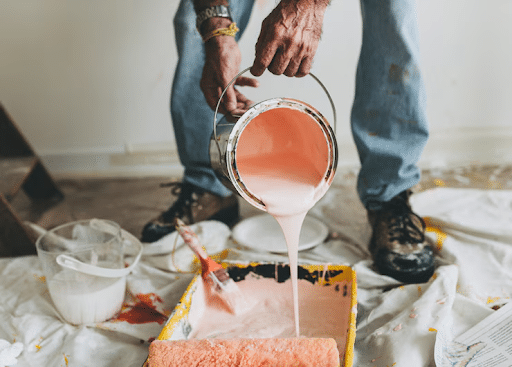Have you ever walked into a freshly painted room and immediately noticed something special about it? Maybe you couldn’t quite put your finger on what made it look so good, but there was definitely something different compared to DIY attempts. That special quality comes from the expertise, techniques, and attention to detail that separates amateur work from professional results.
Finding a Toronto painter who delivers that wow factor might seem challenging, but understanding what makes professional work stand out helps you recognise true quality. The difference isn’t just in the final appearance—it goes much deeper, starting with preparation and extending to the techniques and materials used throughout the process. Knowing these differences helps you make better decisions about your home improvement projects.
The Foundation: Thorough Preparation
Ever heard that saying about success being 90% preparation? For painting, this couldn’t be more accurate. What truly sets apart professional results starts long before the paint touches any surface. The prep work might not be glamorous, but it’s where professionals earn their reputation.
Most homeowners underestimate how much time proper preparation takes. Rushing through this stage leads to peeling paint, uneven coverage, and a finish that won’t stand the test of time. When you cut corners here, the issues will eventually surface, sometimes within months of completion.
Professional painters spend nearly half their project time on preparation alone. They know that properly prepared surfaces accept the adherence of paint better and ensure the durability of their work. This isn’t just about wiping down walls—it’s a comprehensive process that builds the foundation for everything that follows.
Surface Cleaning and Assessment
What’s the first thing that happens before any paint is opened? A thorough examination of all surfaces. Professional painters look beyond what’s visible to the untrained eye, identifying potential problems that could ruin the finished product.
They check for moisture issues, cracks, nail holes, and other imperfections that might need addressing. Using specialised tools, they can detect problems hiding beneath the surface that might cause paint failure later. This detective work happens before any other steps begin.
Water damage, mould growth, and structural issues don’t disappear under a coat of paint. In fact, painting over these problems often makes them worse over time. Professional painters know when to recommend repairs before proceeding, potentially saving you from costly remediation down the road.
Proper Surface Preparation Techniques
Have you ever painted a wall only to see the old colour bleeding through or the new paint bubbling up? These frustrating outcomes usually stem from inadequate preparation. Professional painters employ specific techniques for different surfaces to avoid these issues.
Careful sanding creates the perfect texture for paint adhesion while removing imperfections. Professionals know exactly how much pressure to apply and which grit sandpaper suits each surface type. They understand that over-sanding can damage materials, while under-sanding leaves surfaces too smooth for proper paint adhesion.
Filling holes, cracks, and dents requires selecting the right patching compounds and application methods. Professionals layer these materials carefully, allowing proper drying time between applications. They sand patches until they become invisible under paint, ensuring a seamless final appearance.
Premium Primers and Their Importance
Wondering why professional paint jobs last so much longer? The secret often lies in what you can’t see—the primer coat. Professional painters select specific primers designed for particular surfaces and painting conditions. This isn’t a one-size-fits-all situation.
Different surfaces and paint types require compatible primers. Professionals consider factors like substrate material, previous coatings, moisture conditions, and the chosen finish paint when selecting primers. This technical knowledge comes from years of experience and training.
Some situations call for specialised primers—stain-blocking formulas for water damage, bonding primers for glossy surfaces, or mould-resistant options for bathrooms. The wrong primer choice can undermine even the highest quality topcoat, leading to adhesion failures or colour inconsistencies.
Execution Excellence: Application Techniques
The way paint goes onto surfaces dramatically affects the final look. Have you noticed how professional paint jobs seem smoother, with perfect edges and consistent colour? These results come from refined application techniques that take years to master.
Painting isn’t just about moving a brush across a surface—it’s about controlling paint flow, maintaining wet edges, and achieving consistent coverage. These skills require practice and an understanding of how different paints behave under various conditions.
Temperature, humidity, surface porosity, and even the time of day of application affect how paint performs. Professionals adjust their techniques accordingly, sometimes planning certain tasks for specific times to achieve optimal results. This adaptability separates expert work from amateur attempts.
Brush and Roller Mastery
The humble paintbrush seems simple enough, but in professional hands, it becomes an instrument of precision. Different brush types serve specific purposes—angular brushes for cutting clean lines, round sash brushes for detailed work, and wide flat brushes for broader areas.
Professionals develop a distinctive rhythm and pressure control when using brushes. They know exactly how much paint to load onto the bristles to avoid drips while maintaining efficient coverage. The direction and length of brush strokes affect the final texture and appearance.
Roller techniques involve similar expertise. The pressure applied, rolling speed, and pattern all influence the finished texture. Professionals select specific roller naps for different surfaces and paints, knowing that the wrong combination can create unwanted stippling or insufficient coverage.
Spray Application Finesse
Modern spray equipment delivers factory-like finishes when handled correctly. However, this technology requires substantial skill to master. Professional painters understand spray patterns, overlapping techniques, and distance control that prevent common issues like orange peel texture or uneven application.
Environmental factors become even more critical with spray application. Professionals carefully control overspray and ensure proper ventilation. They mask areas meticulously to protect adjacent surfaces, often spending hours on preparation before spraying for just minutes.
The ability to achieve consistent mil thickness (the measurement of wet paint application) separates professionals from amateurs. Too thick, and the paint may run or crack; too thin, and coverage becomes inadequate. This precision comes from extensive practice and understanding of equipment settings.
Perfect Edge Work and Detail Management
Ever tried painting along a ceiling line or window trim? Those precise edges that professionals achieve don’t happen by accident. Cut-in techniques require steady hands, quality brushes, and practiced movements that come from years of experience.
Professionals often work without taping edges, relying instead on their skill to create clean lines. When they do use tape, they know which types work best on different surfaces and how to seal edges properly to prevent bleed-through—a common frustration for DIYers.
Detailed areas like crown moulding, window mullions, or intricate woodwork demand special attention. Professionals adjust their tools and techniques for these challenges, sometimes using brushes as small as those found in art supplies to achieve perfect results in tight spaces.
Quality Materials: The Professional’s Secret Weapon
Have you ever wondered why professional paint jobs last so much longer than DIY attempts? While skill certainly plays a role, the materials themselves make an enormous difference. Professionals invest in quality products that the average homeowner might not even know exist.
Premium paints contain higher levels of solids, better resins, and finer pigments that create more durable, washable surfaces with superior colour retention. The initial cost difference seems significant, but when factoring in longevity, the professional-grade materials prove more economical over time.
Beyond paint itself, professionals use specialised primers, caulks, patching compounds, and sealants designed for specific applications. These products often aren’t available at typical home improvement stores, representing another advantage of hiring experienced painters.
Paint Selection Expertise
Selecting the right paint involves more than just picking a colour. Professionals consider the surface material, location, exposure to elements, traffic patterns, and desired appearance when recommending specific formulations. This knowledge prevents common failures like peeling in high-moisture areas.
Sheen selection dramatically affects both appearance and durability. Professionals understand which sheens work best in different situations—flat for ceilings and low-traffic areas, satin or eggshell for living spaces, and semi-gloss or gloss for trim and high-wear surfaces.
They’re also knowledgeable about newer specialty paints with specific properties—scuff resistance for hallways, antimicrobial formulations for kitchens and baths, or low-VOC options for environmentally sensitive clients. This expertise ensures you get the right product for each unique situation.
Colour Consistency and Management
Have you ever painted multiple walls with the same colour only to notice slight variations between them? Professional painters use methods to ensure perfect colour consistency throughout your space. They often box (combine) multiple paint cans together to eliminate batch variations.
Lighting dramatically affects how colours appear. Professionals understand how natural and artificial light interact with different pigments, helping clients avoid unexpected surprises when colours look different at various times of day. This knowledge prevents expensive colour mistakes.
They also recognise how adjacent colours influence perception, understanding colour theory principles that help create harmonious schemes. This expertise helps them guide clients toward selections that will satisfy long-term rather than causing regret after the project completes.
The Invisible Difference: Longevity and Durability
The true test of any paint job happens long after the painters leave. How does it look six months later? A year? Five years? Professional work stands the test of time in ways that amateur efforts simply can’t match, and this durability stems from factors that aren’t immediately visible.
Weather resistance, colour fastness, and structural integrity result from the combination of proper preparation, quality materials, and expert application. When all three elements come together correctly, the paint becomes a protective skin that enhances and preserves your property.
Professionals understand how buildings move and breathe with seasonal changes. They account for these movements in their preparation and application methods, preventing cracks and failures that often plague DIY paint jobs after just one season of expansion and contraction.
Conclusion
The difference between average and exceptional paint jobs often lies in details you might never notice unless they’re pointed out. From meticulous preparation to masterful application techniques, professional painters bring knowledge and skills that transform ordinary spaces into showcases. Quality materials complete the formula, ensuring results that not only look stunning immediately but continue impressing for years to come. Next time you’re comparing quotes or considering whether to hire help, remember that the true value of professional painting extends far beyond the immediate visual impact—it’s an investment in your property’s appearance and protection that pays dividends with every passing season.







